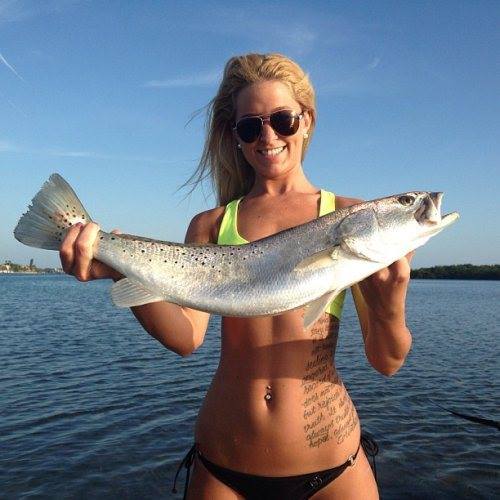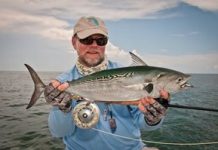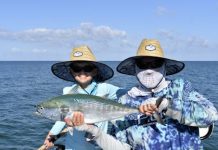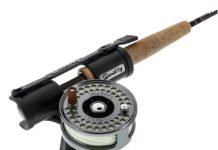By CAPT. PAT DAMICO, CapMel.com Fly Fishing Editor

Big aggressive “yellow mouths” seem to have different characteristics than their smaller brothers and sisters. In order to pile on the fat, they must find a good source of protein, requiring little effort to harvest. Finding schools of baitfish will lead you to these opportunistic predators. Besides baitfish, shrimp and crabs become an important source of nutrition. Finding schools of baitfish will lead you to these opportunistic predators. Besides baitfish, shrimp and crabs become an important source of nutrition. The 2005 red tide effects had devastated trout in some areas, while other waters harbor some very healthy trout populations. Clearer water is also one of the results of the prolonged exposure to the red tide.
Large numbers of smaller trout have been our reward when we start the day early fishing some deeper “holes” left at low tide. A few reds also seek this deeper water haven. As the tide starts to come in, the exposed flat, heated by the sun, will be a few degrees warmer. Depending on its location, a dark sun exposed flat away from direct wind can be at least eight degrees warmer than adjacent deeper water. A careful observer will see activity on this flat in the form of small baitfish looking for a comfortable place to seek food. Why do some flats have a lot of wading birds, while others have none? They eat the same things that fish eat. Skip the shallow water that is devoid of birds, and find a flat that is loaded with food. The fish that have been around awhile know where they are; you should too.
A diary that has entries after every trip is one of my most valuable tools. At the beginning of a new month, I review the notes made during previous years. This will give me a wealth of information not only where to fish, but also places to avoid. Every trip should begin with a plan of how to structure your day. Information you have entered in your own writing should contain weather, wind, water temperature, time of day, location, productive areas, as well as places that did not have fish. Flies that produced, depth fished and type of retrieve should also be noted.

In order to get to the shallows, you generally must cross deeper water. Probe these edges with a sinking tip line and weighted fly. A cut in the flat that leads to the shallows may be a migration route for fish. On more than one occasion I blew large fish out of such a place because I was a little early and in a hurry. Be very stealthy, use a push pole or slow running electric, and make long casts. When fishing the holes, I generally use smaller flies. A floating line with at least a nine foot leader will be used in the shallows. Since I am targeting larger fish, I will use big flies, size one, or larger. Bulky dressing is not needed. Barbs are always mashed down so that a dehooker, or long nose pliers, can remove the fish while in the water without the need to touch it. Materials that undulate in the current with minimum stripping will produce. Deceivers of the soft hackle variety as recommended by Jack Garthside will work and cast easily. They will land with a minimum of surface disturbance. Brown over orange is one of my favorite winter combinations. Darker colors will duplicate baitfish, other than greenbacks, that are a staple of a large trout’s winter diet. A minnow type pattern will cover more water than a crab or shrimp fly. It is surprising how well a large trout is camouflaged. Sight casting to these big boys will have your knees knocking.
Most strikes will be very aggressive! In deeper water, they will often follow and take with a soft inhale. Not so in the shallows. I have often thought a large snook hammered my fly, only to have a gator trout as my reward.
If some of your trout spots have never produced large fish during warm weather, give them a try now. You might be in for a big surprise and a lot of excitement.
- Captain’s Corner:Pat Damico - June 25, 2019
- Flat water makes seeing tarpon easier - May 17, 2017
- Warm rivers holding plenty of targets for fly fishermen - February 16, 2017











